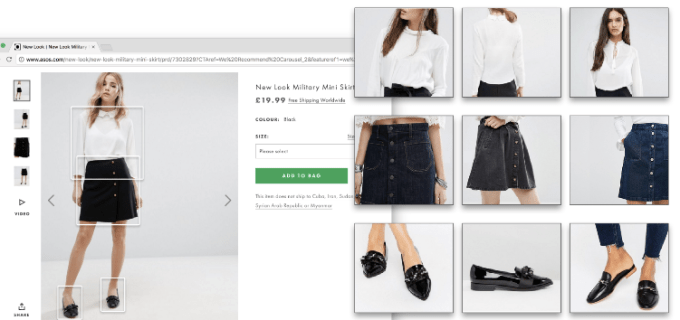Syte.ai, a visual search startup focused on fashion products, announced that it has raised an $8 million Series A. The lead investor is NHN Ventures (the investment arm of Korean internet services giant NHN), with participation from Naver Corp., messaging app Line Corp., Magma VC, Remagine VC, KDC Ventures, and NBM Ventures.
Co-founder and CMO Lihi Pinto Fryman was working as an investment banker in London when a red dress in Vogue caught her eye. She tried to find a similar one online, but couldn’t.
“I said to my husband, how can it be that in 2014 I see a dress that I really like and can’t just tap it and get it?” she told TechCrunch. The two started looking at ways to build a better visual search engine and in 2015 teamed up with CTO Dr. Helge Voss and COO Idan Pinto to launch Syte.ai (Lihi’s husband, Ofer Fryman, a former account executive at Hewlett-Packard, is CEO).
Syte.ai’s Series A will be used for marketing and growth in the U.S., where it hopes to sign up large fashion publishers and retailers. Of course, with Syte.ai’s new roster of investors, it’s fair to assume that it will also look for deals in Asia. Fryman declined to talk about potential partnerships, but said Syte.ai’s new Asian backers, including NHN and Line, have been “searching for a while to find the most accurate deep-learning technology that can make images shoppable.”
In a prepared statement, Woo Kim, managing director and partner of NHN Investment, said that many next-generation search solutions have delivered disappointing results so far.
“It was largely because such below-average image search results were driven by essentially the same deep learning approach, and the only differentiation was how many sample images you have to train your database,” he added. “Syte.ai’s unique approach of redefining how machines understand images is simply ground-breaking innovation. We believe that Syte.ai will disrupt the way industry adopts image search technology.”
Syte.ai’s founders have spent the last three years developing its deep-learning algorithms, which Fryman describes as “building a bridge between physics and fashion.” Fryman says Syte.ai is different from its competitors because its deep learning-based search engine focuses only on fashion products, even though there are other verticals, such as home decor, where visual search is also in demand. Its main business are search tools for online publishers and retailers, but it also has several consumer products, including a Chrome extension called Fashion Lover, and Glamix, a chatbot.
The startup is just one of several that are tackling visual search as online businesses try to reduce their dependency on banner ads and find ways to monetize that are better suited to mobile screens. Other companies in the same space include Slyce, Clarifai, and Visenze, which is itself funded by another one of Asia’s leading Internet firms, Rakuten.
“The reason we chose fashion is because it’s so hard to recognize,” says Fryman. “Think about your top. It looks completely different if you are wearing it, or if it’s on a hanger, or in a catalog, or if you are walking on a red carpet or sitting down. It’s hard to teach the machine it’s the same item.”
After a site integrates Syte.ai’s search technology, users can hover their cursor over an item in a photo and automatically get results for similar products that are on sale. For publishers, including fashion blogs and magazines, Syte.ai displays items from a range of stores and price points to increase the chances that the user will click on at least one result. The company monetizes by sharing revenue with publishers and charging e-commerce stores a subscription fee.
One of the main attractions for online stores is that Syte.ai’s search engine can help customers find alternative items if what they want is out of stock. According to a study by IHL Group, “out-of-stocks” cost retailers about $634.1 billion a year. It also helps sites turn over “indexed” inventory, or items overlooked by customers because they aren’t on the front page (at larger sellers, this can potentially be hundreds of items). Visual search is especially crucial for mobile shopping, where customers want to see as many results displayed as quickly as possible on their small screens. Once Syte.ai perfects visual search for fashion, Fryman says, it will move onto other verticals.
































Comment